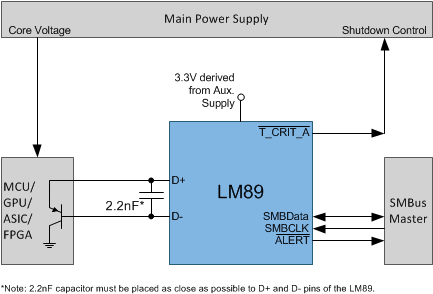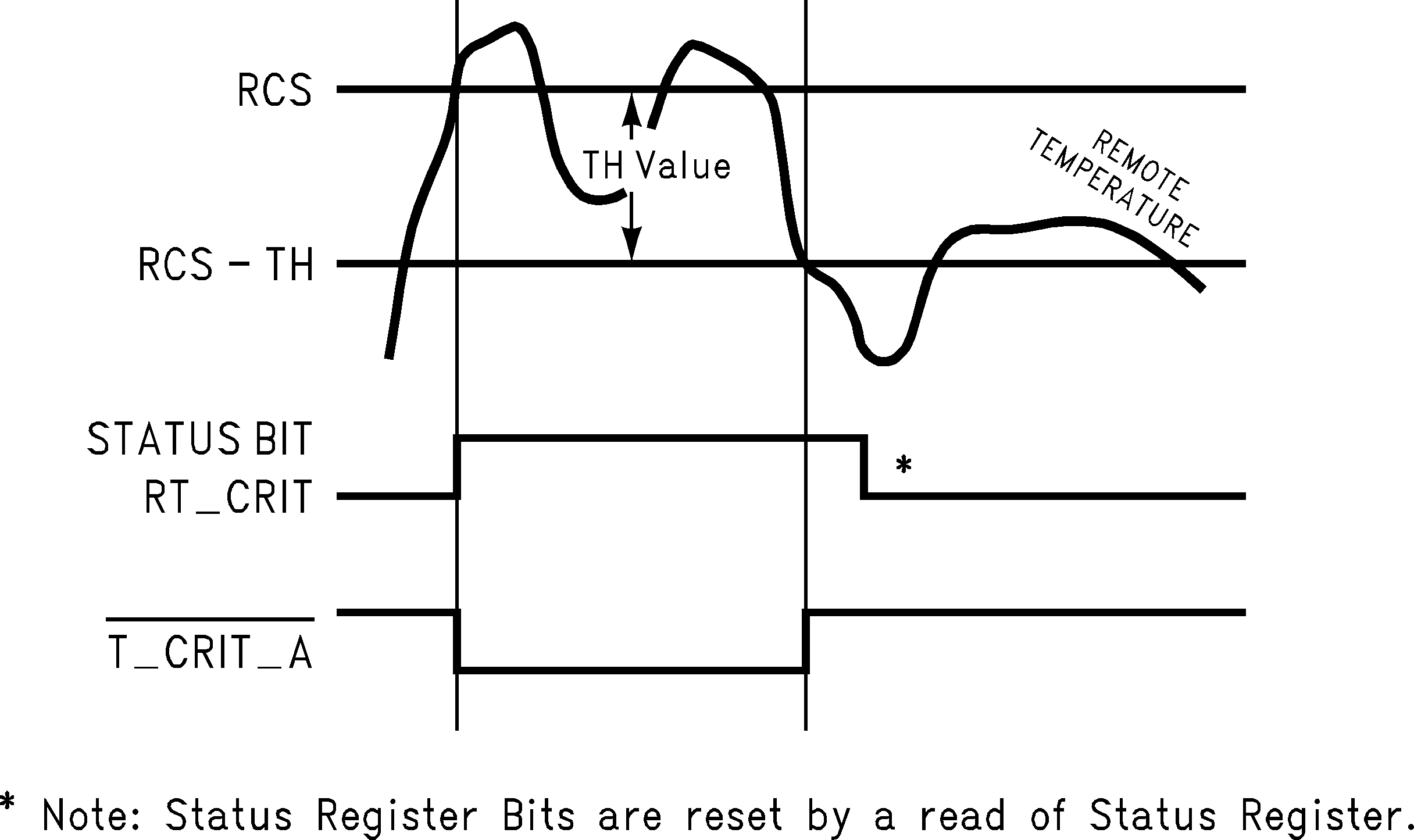SNIS128D August 2002 – June 2014 LM89
UNLESS OTHERWISE NOTED, this document contains ADVANCE INFORMATION for pre-production products; subject to change without notice.
- 1 Features
- 2 Applications
- 3 Description
- 4 Remote Diode Temperature Sensor System Diagram
- 5 Revision History
- 6 Device Comparison Table
- 7 Pin Configuration And Functions
- 8 Specifications
-
9 Detailed Description
- 9.1 Overview
- 9.2 Functional Block Diagram
- 9.3
Feature Description
- 9.3.1 Conversion Sequence
- 9.3.2 The ALERT Output
- 9.3.3 T_CRIT_A Output And T_CRIT Limit
- 9.3.4 Smbus Interface
- 9.3.5 Temperature Data Format
- 9.3.6 Open-Drain Outputs
- 9.3.7 Diode Fault Detection
- 9.3.8 Communicating With The LM89
- 9.3.9 Serial Interface Reset
- 9.3.10 Digital Filter
- 9.3.11 Fault Queue
- 9.3.12 One-Shot Register
- 9.4 Device Functional Modes
- 9.5 Programming
- 9.6
Register Maps
- 9.6.1 Command Register
- 9.6.2 Local And Remote Temperature Registers (LT, RTHB, RTLB)
- 9.6.3 Status Register (SR)
- 9.6.4 Configuration Register
- 9.6.5 Conversion Rate Register
- 9.6.6 Local And Remote High Setpoint Registers (LHS, RHSHB, And RHSLB)
- 9.6.7 Local And Remote Low Setpoint Registers (LLS, RLSHB, And RLSLB)
- 9.6.8 Remote Temperature Offset Registers (RTOHB And RTOLB)
- 9.6.9 Local And Remote T_crit Registers (RCS And LCS)
- 9.6.10 T_CRIT Hysteresis Register (TH)
- 9.6.11 Filter And Alert Configure Register
- 9.6.12 Manufacturers Id Register
- 9.6.13 Die Revision Code Register
- 10Application and Implementation
- 11Power Supply Recommendations
- 12Layout
- 13Device and Documentation Support
- 14Mechanical, Packaging, and Orderable Information
Package Options
Mechanical Data (Package|Pins)
Thermal pad, mechanical data (Package|Pins)
Orderable Information
1 Features
- Accurately Senses Die Temperature of Remote ICs or Diode Junctions
- Offset Register Allows Accurate Sensing of a Variety of Thermal Diodes
- On-Board Local Temperature Sensing
- 10-Bit Plus Sign Remote Diode Temperature Data Format, 0.125°C Resolution
- T_CRIT_A Output Useful for System Shutdown
- ALERT Output Supports SMBus 2.0 Protocol
- SMBus 2.0 Compatible Interface, Supports TIMEOUT
- 8-Pin VSSOP and SOIC Packages
- Key Specifications:
- Supply Voltage: 3.0 V to 3.6 V
- Local Temp Accuracy (includes quantization error)
- TA = 25°C to 125°C ±3.0 °C (max)
- Remote Diode Temp Accuracy (includes quantization error)
- TA = 30°C, TD = 80°C ±0.75 °C (max)
2 Applications
- Processor/Computer System Thermal Management
(For Example, Laptop, Desktop, Workstations, Server) - Electronic Test Equipment
- Office Electronics
3 Description
The LM89 is an 11-bit digital temperature sensor with a 2-wire System Management Bus (SMBus) serial interface. The LM89 accurately measures its own temperature as well as the temperature of an external device, such as processor thermal diode or diode-connected transistor such as the 2N3904. The temperature of any ASIC, GPU, FPGA or MCU can be accurately determined using the LM89 as long as a dedicated diode (semiconductor junction) is available on the target die. The LM89 has an Offset register to allow calibration for different nonideality factors without requiring software management.
Activation of the ALERT occurs when any temperature goes outside a preprogrammed window set by the HIGH and LOW limit registers or exceeds the T_CRIT limit. Activation of the T_CRIT_A occurs when any temperature exceeds the T_CRIT programmed limit.
The LM89 is pin and register compatible with the LM86, LM90, LM99, On Semiconductor ADM1032 and Maxim MAX6657/8.
The LM89C and the LM89-1C have the same functions but different SMBus slave addresses, allowing multiple LM89's on a bus. LM89-1D's default local T_CRIT temperature limit is 105°C; all other versions are 85°C. (See Device Comparison Table.)
Device Information(1)
| PART NUMBER | PACKAGE | BODY SIZE (NOM) |
|---|---|---|
| LM89-1D | VSSOP (8) | 3.0 mm x 3.0 mm |
| LM89C | SOIC (8) | 4.9 mm x 3.9 mm |
- For all available packages, see the orderable addendum at the end of the datasheet.
4 Remote Diode Temperature Sensor System Diagram

T_CRIT_A Temperature Response Diagram
